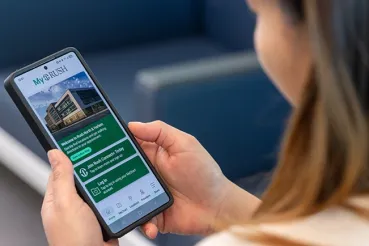Spurred by the COVID-19 pandemic, telehealth has become an essential part of health care.
It started when, in response to COVID-19, Illinois Gov. J.B. Pritzker and the Department of Healthcare and Family Services lifted longstanding barriers to receiving health care via telehealth for certain commercial health plans and Medicaid. Rush and other health systems responded rapidly to adjust clinical workflows and educate staff on telehealth.
But for the past year, even as the use of telehealth skyrocketed, lawmakers have hotly debated whether telehealth visits should be covered the same way that in-person visits are covered.
The debate is finally over. In May, groundbreaking telehealth legislation for Illinois, House Bill 3308, passed unanimously in the Illinois Senate and the House; and on July 22, Pritzker signed the bill into law.
This legislation strengthens existing laws around telehealth coverage and ensures that patients and providers are protected from attempts to limit telehealth access. The new law only applies to individual or group policies of accident or health insurance regulated in Illinois. Federal mandates related to telehealth are still pending guidance and legislation via the Center for Medicare and Medicaid Services. To determine if your insurance plan is within the purview of this new law, you should contact your health plan administrator.
Meeta Shah, MD, a Rush emergency department physician and leader of Rush’s telehealth program, says this legislation is exactly what patients need: “As an emergency department physician, I see a lot of patients who struggle with getting access to care due to lack of transportation, long work hours, not having a family member or caregiver to help them or various other reasons,” she says. “Over 80% of Americans have a smartphone now, and I think it’s long overdue to give them the opportunity to seek preventive care at their convenience, with insurance coverage.”
Here, Shah shares five important things to know about this new legislation and what it means for you and your family.
1. Coverage for telehealth services has expanded.
The new telehealth legislation requires that certain individual or group policies of accident or insurance in Illinois cover clinically appropriate, medically necessary telehealth services (real-time audio or audio/video interactions), E-Visits (patient portal communications) and virtual check-ins (5- to 10-minute “live” conversations to prevent an in-person visit) in the same way as any other benefits covered under the policy.
“Expanding insurance coverage of telehealth in this way means a revolution in access to care. Telehealth can finally meet its full potential and provide patients with the access that they deserve,” says Shah.
In addition, the legislation states that insurers may cover remote patient monitoring, and that they must cover telehealth services for licensed dietitian nutritionists and certified diabetes educators who counsel diabetes patients in the patients' homes. This coverage was previously limited to seniors.
2. Reimbursement rates are now equal.
The new legislation requires that individual or group policies of accident or insurance in Illinois reimburse in-network health care professionals and facilities for telehealth services in the same manner and the same rate that they reimburse for in-person services. This requirement lasts until 2027, and Illinois has a task force in place to review and recommend a long-term solution.
“I think telehealth has the potential to reduce health care spending, when supported consistently,” Shah says. “Requiring insurers in Illinois to reimburse telehealth services at the same rate as in-person services is a huge step toward that.”
3. There are new patient protections.
The new telehealth legislation requires many protections for patients when it comes to telehealth. Here are just a few:
- What a patient pays for a telehealth visit (often called cost-sharing) is required to be no more than what they would normally pay in person.
- Commercial insurers in Illinois cannot require in-person contact between a health care professional and a patient before the telehealth service is provided.
- Patients do not need to demonstrate a hardship or access barrier to an in-person visit to be able to use telehealth.
- Commercial insurers in Illinois cannot restrict telehealth services geographically.
All of these requirements help make it easier for patients to access telehealth. “Telehealth visits are often easier for patients to attend. If they have time on their lunch break, they can hop on and have a visit and get the care they need,” says Shah. “When patients don’t have that access and can’t physically come to us, they stay home and risk getting sicker.”
4. The scope of telehealth-approved services is now broader.
The new legislation clarifies that mental health and substance use disorder treatment and services are health care services that may be provided via telehealth, regardless of patient location.
Early intervention providers (providers who help evaluate children to discover delays in movement, learning or behavior) are also permitted to deliver telehealth services, in the same way they would for in-person services. Parents may choose whether services are delivered in person or via telehealth. Other forms of telehealth were also clarified as methods of telehealth: asynchronous store and forward system, remote patient monitoring technologies, E-Visits and virtual check-ins. To learn more about the different types of telehealth, check out our article here.
5. Medicaid telehealth coverage remains in place.
The telehealth legislation also continues the existing Medicaid telehealth coverage and reimbursement requirements for Medicaid fee-for-service and managed care programs. The Department of Healthcare and Family Services will continue to meet with industry associations and stakeholders to consider further expansion.
Telehealth is for everyone
According to the American Telemedicine Association, “Providers that offer video-enabled options, like virtual urgent care and virtual doctor’s visits, find that many patients prefer telehealth as a time-saving alternative to in-person appointments.”
And the benefits go beyond convenience. A 2019 federal systematic review of telehealth for acute and chronic care consultations found that telehealth outcomes are generally either better than or as good as in-person visits.
“Telehealth is really for everyone — from children to seniors,” Shah says. “It can make your life easier and can help you take care of yourself in a holistic way. We should all care about that.”
To learn more about telehealth in Illinois, visit protectillinoistelehealth.org.





